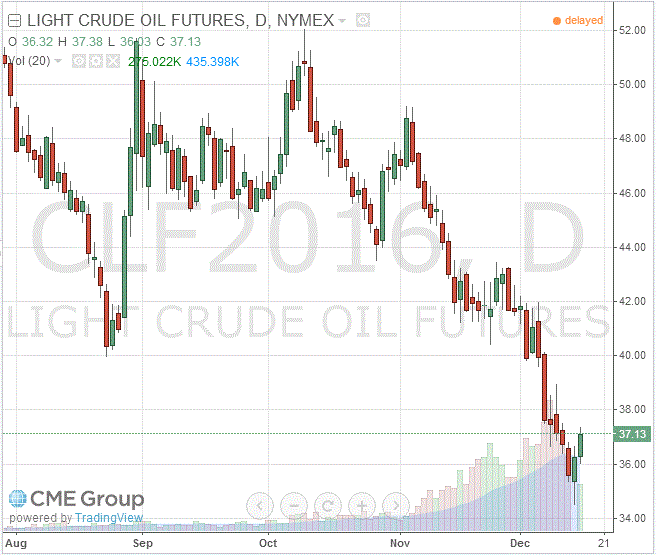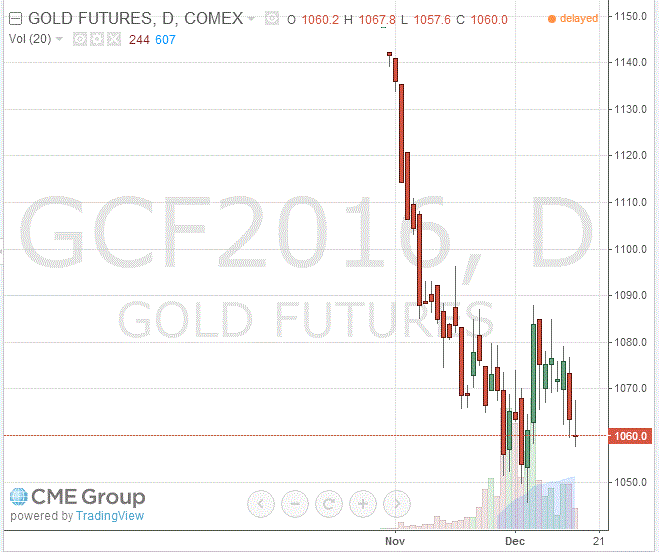Noticias del mercado
-
17:54
Oil prices rise but gains were limited by concerns over global oil oversupply
Oil prices rose but gains were limited by concerns over global oil oversupply. Market participants are awaiting the release of the Fed's monetary policy meeting results on Wednesday. Analysts expect the Fed to raise its interest rate.
Speculation that U.S. Congress could lift the ban on U.S. crude oil exports supported oil prices.
Moody's Investors Service lowered its oil forecasts on Tuesday. The agency expects Brent price of $43 a barrel in 2016, down from an earlier forecast of $53, and WTI price of $40 per barrel in 2016, down from an earlier forecast of $48. Brent and WTI prices are expected to increase $5 per barrel in 2017 and 2018.
O PEC Secretary General Abdullah al-Badri said on Tuesday that oil prices could climb in a few months or a year.
Market participants are awaiting the release of U.S. crude oil inventories data. The American Petroleum Institute (API) is scheduled to release its U.S. oil inventories data later in the day, and U.S. oil inventories data from the U.S. Energy Information Administration is expected on Wednesday.
WTI crude oil for January delivery rose to $37.13 a barrel on the New York Mercantile Exchange.
Brent crude oil for January increased to $38.75 a barrel on ICE Futures Europe.
-
17:31
Gold trades little changed ahead the release of the Fed's monetary policy meeting results on Wednesday
Gold price traded little changed ahead the release of the Fed's monetary policy meeting results on Wednesday. Analysts expect that the Fed will start raising its interest rate this month.
Gold is traded in U.S. dollars. It suffers when the U.S. dollar strengthens, becoming more expensive for holders of other currencies.
Market participants eyed the U.S. consumer price inflation data. The U.S. Labor Department released consumer price inflation data on Tuesday. The U.S. consumer price inflation was flat in November, in line with expectations, after a 0.2% rise in October.
On a yearly basis, the U.S. consumer price index increased to 0.5% in November from 0.2% in October, beating expectations for a rise to 0.4%.
The inflation remains low due to low oil prices.
The U.S. consumer price inflation excluding food and energy gained 0.2% in November, in line with expectations, after a 0.2% increase in October.
On a yearly basis, the U.S. consumer price index excluding food and energy increased to 2.0% in November from 1.9% in October, in line with expectations.
The increase of the consumer price index excluding food and energy was driven by higher prices of rents, airline fares, new motor vehicles and medical care.
The consumer price index is not preferred Fed's inflation measure.
January futures for gold on the COMEX today traded at 1060.00 dollars per ounce.
-
07:33
Oil prices extended declines
West Texas Intermediate futures for January delivery is currently at $36.22 (-0.25%), while Brent crude is at $37.78 (-0.37%) amid persistent global supply glut concerns, which pushed prices down to nearly 11-year lows on Monday.
The latest IEA monthly report said the growth of global oil demand will slow to 1.2 million barrels a day next year compared with 1.8 million barrels a day in 2015. Meanwhile OPEC suggests global demand growth to slide to 1.25 million barrels a day from 1.53 million barrels a day in the current year. Market participants are also preparing for additional supplies from Iran, which are expected to hit the market next year.
Meanwhile the weather outlook suggests a mild winter, which will not boost demand for heating. According to BNP Paribas Russia, Canada, the U.S., Japan and South Korea will see milder than normal temperatures in the next two weeks.
Investors are also preparing for the two-day Fed meeting, which starts later today.
-
07:10
Gold steady after a fall
Gold is currently at $1,063.20 (-0.02%) after it suffered a heavy loss in the previous session as investors prepared for the beginning of the Fed two-day policy meeting on Tuesday. The central bank of the U.S. is widely expected to raise rates to a range of 0.25%-0.50% from 0%-0.25%. Higher rates increase the opportunity cost of holding the non-interest paying precious metal and reduce demand for it. Bullion has already lost 9% of its price this year.
Assets in SPDR Gold Trust, the biggest gold exchange traded fund, are at their lowest since September 2008, while options data suggest that investors are ready for the price to decline to $1,000 an ounce.
-
00:35
Commodities. Daily history for Dec 14’2015:
(raw materials / closing price /% change)
Oil 36.27 -0.11%
Gold 1,059.60 -0.36%
-


